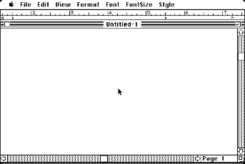WriteNow
WriteNow was one of the two original word processor applications developed for the launch of the Apple Macintosh in 1984, and was the primary word processor for computers manufactured by NeXT. WriteNow was purchased from T/Maker by WordStar in 1993, but shortly after that, WordStar was purchased by The Learning Company, which ended sales. It had a combination of powerful features, excellent performance, and small system requirements.
History
WriteNow was written for Apple Computer, Inc. by John Anderson and Bill Tschumy in Seattle, separate from the Macintosh computer and MacWrite word processor development teams. Steve Jobs was concerned that those programming MacWrite were not going to be ready for the 1984 release date of the Macintosh; he therefore commissioned a team of programmers to work independently on a similar project, which eventually became WriteNow. Members of the WriteNow team knew about MacWrite, but members of the MacWrite team did not know about WriteNow.
Ultimately, MacWrite was completed on schedule and shipped with the Macintosh. This left WriteNow in limbo until Jobs left Apple to form NeXT. WriteNow was owned by NeXT, and released for the Macintosh in 1985, published by the T/Maker Company.
Features

WriteNow improved on some of the limitations of MacWrite through the better handling of large documents and the addition of features such as spell check and footnotes. It was "lean and fast," being written entirely in assembly language, and could fit with the Macintosh operating system on a bootable 400 KB floppy disk. WriteNow went through several versions, culminating (in 1993) with version 4.0.2, which continued the "lean and fast" reputation while adding features such as tables and definable styles.
In the opinion of many of its users, WriteNow represented the ideal Macintosh application. It had a simple, intuitive graphical user interface (GUI), no copy protection, and it worked in practically every revision of the Macintosh operating system, including in the Mac 68k emulator on PowerPC Macs and in the Classic Environment under Mac OS X. Its biggest claim to fame, however, was its speed. It was written in assembly language (Motorola 680x0) by a group of developers who had a reputation for producing extremely efficient code. The user interface was unusual in that, while the typical word processor had a ruler embedded in the main document window, WriteNow used a separate, fixed window that could be sent into the background, freeing screen space on the compact Mac's small nine-inch screen to display an additional line or two of text.
NeXT port
WriteNow was ported to the NeXT operating system and was subsequently bundled with NeXT stations until 1991. WriteNow was written in 68k assembly language and, like the contemporary Mac platform, NeXT hardware was based on the 68k architecture. Due to concerns of third-party publishers such as WordPerfect over the issue of competing with a free word processor, ownership of WriteNow for NeXT was transferred to T/Maker and the NeXT operating system shipped without a full-featured word-processing program.
Reception
Compute!'s Apple Applications in 1987 wrote that "WriteNow is the Pegasus of Macintosh word processors—swift, easy to learn and use, and packed with power".[1]
Discontinuation
Around 1993, rights to WriteNow (for both Macintosh and NeXT operating systems) were purchased by WordStar. Shortly after that, WordStar was purchased by The Learning Company, and WriteNow was discontinued. The lifecycle of computers using the 680x0 architecture was coming to an end, and the architecture-specific assembly language code that made WriteNow so much faster than its competitors also made it much more difficult to port to the new PowerPC processor than competing word processors written in high-level languages such as C.
See also
References
- McNeill, Dan (December 1987). "Macintosh: The Word Explosion". Compute!'s Apple Applications. pp. 54–60. Retrieved 14 September 2016.
External links
- WriteNow: Latest Info at the Wayback Machine (archived April 26, 2009)